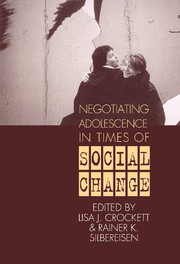Book contents
- Frontmatter
- Contents
- Contributors
- Preface
- 1 Social Change and Adolescent Development: Issues and Challenges
- Part I Models of Social Change Effects
- Part II Social Change and Adolescent Transitions
- Part III Social Change and Adolescents' Social Contexts
- Part IV Implications of Social Change for Adolescent Health and Well-Being
- Part V Interventions: Promoting Healthy Development in Times of Social Change
- 16 Research, Intervention, and Social Change: Improving Adolescents' Career Opportunities
- 17 Preparing Adolescents for Social Change: Designing Generic Social Interventions
- 18 Adolescents in the 21st Century: Preparing for an Uncertain Future
- Endnotes
- Index
17 - Preparing Adolescents for Social Change: Designing Generic Social Interventions
Published online by Cambridge University Press: 26 January 2010
- Frontmatter
- Contents
- Contributors
- Preface
- 1 Social Change and Adolescent Development: Issues and Challenges
- Part I Models of Social Change Effects
- Part II Social Change and Adolescent Transitions
- Part III Social Change and Adolescents' Social Contexts
- Part IV Implications of Social Change for Adolescent Health and Well-Being
- Part V Interventions: Promoting Healthy Development in Times of Social Change
- 16 Research, Intervention, and Social Change: Improving Adolescents' Career Opportunities
- 17 Preparing Adolescents for Social Change: Designing Generic Social Interventions
- 18 Adolescents in the 21st Century: Preparing for an Uncertain Future
- Endnotes
- Index
Summary
Current social interventions aimed at adolescents rarely seek to prepare them for living under conditions of rapid, often unpredicted social change. Instead, interventions tend to target single problems, such as the prevention of teenage pregnancy, substance abuse, school dropout, HIV, and violence. Some of these approaches (Botvin, Baker, Dusenbury, Botvin, & Diaz, 1995) incorporate social or life skills that are more generic in nature and aim to increase a young person's capacity to deal with stress, uncertainty, and conflict. The irony of these targeted interventions, however, is that the psychosocial disorders they seek to prevent or treat are likely to be responses to the very strains of social change experienced by contemporary adolescents (Chisholm & Hurrelmann, 1995; Rutter & Smith, 1995).
The school-to-work area (Hamilton and Hamilton, this volume; Marshall, 1997) is an exception to targeted interventions that do not typically concern themselves with future life challenges for adolescents. Yet even in the work preparation area, some labor economists admit to limits in forecasting the requirements of the future workplace (Nadel, 1997).
The nature of future changes in work, family life, communities, and nations is not easily predicted. Often these changes, such as recent political and economic developments in central and Eastern Europe, occur unexpectedly (Ringen &Wallace, 1994). Forecasts of a global economy (Reich, 1991) with its political and social ramifications (Schwab & Smajda, 1996) are abundant. Adolescents must be prepared to compete in aworldwide labor market and must have the skills to understand and appreciate cultures other than their own. For those who will become part of the business and financial sector, such appreciation must also translate into behaviors that reflect intergroup cultural competence.
- Type
- Chapter
- Information
- Negotiating Adolescence in Times of Social Change , pp. 284 - 293Publisher: Cambridge University PressPrint publication year: 1999
- 1
- Cited by

